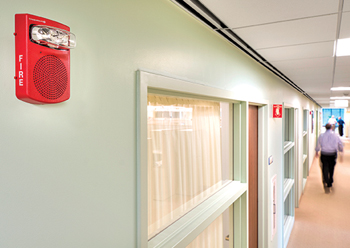Johnson Controls’ system receives UL nod
01 March 2020
Johnson Controls says the innovative self-test technology of its addressable fire alarm notification appliances has become the first in the fire protection industry to receive the UL Verified Mark.
The UL Verified Mark validates that TrueAlert ES self-test technology accurately tests and confirms the operational status of compatible notification appliances, according to an official for Johnson Controls. The revolutionary feature provides a non-disruptive appliance testing solution for commercial buildings and eliminates costly after-hours device testing, adds Bruce W Marien, product manager, Notification, Johnson Controls.
“Johnson Controls was the first company to offer self-testing fire alarm devices, and we’re now the first to receive the UL Verification Mark for the technology,” says Marien. “UL has tested and confirmed the performance of our self-testing appliances so customers can be confident that the product will add convenience to their operations and dramatically reduce disruption to building occupants.”
Available on compatible Simplex and Autocall TrueAlert ES addressable notification systems, the self-testing feature allows technicians to programme the fire panel to manually or automatically test a group of devices or the entire system. Each device will produce an audible sound and/or visible output. The results are then stored in the panel for convenient reporting and reviewing.
Users can programme the panel to schedule automatic tests at times when buildings are unoccupied to help avoid disturbance or inconvenience to occupants. When manual testing is required users can switch the system into manual test mode and check devices using a hand-held magnet.
“The self-test capability helps enhance building safety and fire detection system reliability by allowing for frequent automatic testing of fire detection systems. It gives building staff peace of mind knowing the appliances will work when necessary,” he says.
According to Marien, a recent independent study showed the Johnson Controls self-test capability detected non-operational units in 100 per cent of tests. In addition, false negatives (identifying a non-operational device even though it had performed properly) were less than one per cent. The test also confirmed the appliances function as specified in the automated test section of NFPA 72.
If a performance issue does occur, the system will pinpoint the exact device with the problem and address it. Users can view and print test results directly from the panel or through a Simplex or Autocall TrueSite Workstation.
“UL’s marketing claim verification programme helps meet the need for more transparency from the brands people choose,” says Kevin Faltin, vice president of UL’s Building and Life Safety Technologies division. “This objective, third-party verification allows Johnson Controls to stand out from those with self-declared or unsubstantiated claims.”
Meanwhile, to meet the requirements of the latest UL standards that will take effect in June next year, Johnson Controls is introducing advanced smoke sensors built upon the established performance of its flagship TrueAlarm technology.
Elaborating on these latest standards, Wayne Aho, senior product manager, Sensors, Johnson Controls, says: “The latest updates to UL 268, Standard for Safety of Smoke Detectors for Fire Alarm Systems, call for significant improvements to smoke detection technology. Set to take effect in June 2021, the new UL 268 seventh edition standard requires smoke sensors, detectors and smoke alarms to pass more than 215 new or revised performance tests, including three new challenging tests: a cooking nuisance alarm test, a flaming polyurethane foam test and a smoldering polyurethane test.
“The UL seventh edition polyurethane tests better represent the type of smoke and flames produced in modern building fires due to the increased use of synthetic furnishing materials that can ignite and burn faster than other materials. The cooking test was added after research showed people frequently disable smoke alarms due to nuisance alarms caused by cooking and shower steam.”
The new TrueAlarm sensors provide earlier detection, better fire type recognition and fewer nuisance alarms, he says. They use sophisticated algorithms to analyse particles and determine whether they are generated by an actual fire rather than smoke or steam from cooking.
Sensor alarm points can be programmed for timed, multi-stage operation per sensor. A lower percentage alert can cause a warning prompt to investigate the issue while a higher programmed percentage will initiate an alarm.
“The design of our new sensors is based on decades of fire detection experience and demonstrates our commitment to creating the most innovative and reliable products in the industry,” says Aho. “These re-designed smoke sensors reduce the number of nuisance alarms while providing early notification, when needed, to help building occupants evacuate quickly and safely during a fire event.”
The ability of the redesigned TrueAlarm sensors to intelligently differentiate between high-risk fires and burning food or steam is especially important for commercial spaces such as hotels, dormitories, hospitals and other facilities that are prone to nuisance alarms.
The new seventh edition-compliant TrueAlarm sensors will be available for both the Simplex and Autocall product families in the Spring of 2020.
- Intumescents offer aesthetics, safety
- New fire-retardant PU foam launched in UAE
- Hormann unveils FlexFire curtain
- Hempel launches new fire protection coating
- Johnson Controls’ system receives UL nod



